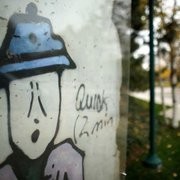Chunk of the Berlin Wall
Introduction
Text-to-speech Audio
Images
A side view of the portion of the Berlin Wall.

Backstory and Context
Text-to-speech Audio
After the end of World War Two, Germany was split into four zones of occupation in which France, Britain, The United States, and the Soviet Union each controlled a portion of the country. While there were large segments of land controlled by foreign countries, the city of Berlin was further split by these four powers. The discrepancies in vision for what post-war Europe should look like led to the Cold War, which began in 1946. Tensions between the Soviet Union and the other countries involved in the Potsdam Conference continued to accumulate as both the United States and the Soviet Union disagreed on the political structure of post-war Europe.
The tensions between these two ‘superpowers’ began to take physical form in Germany with the official political separation between East and West Germany - where West Germany (the Federal Republic of Germany) was supported by The United States, and East Germany (the German Democratic Republic) was backed by the Soviet Union. At the time of the creation of these two states, it was not uncommon to find East Germans escaping across the border to the more prosperous West Germany (Ahonen 42). Largely influenced by East Germany, the Berlin Wall was constructed in reaction to the fleeing of people migrating to West Germany in the hopes of achieving a more prosperous and free life.
Construction of the Wall began in 1961 and initially took the form of a wire fence that separated neighborhoods and families overnight (Murph et al. 379). This crude wire fence developed into two 13-foot walls spanning 96 miles, where it would remain for a period of 28 years. Individuals would attempt to sneak through the border often, by 1989 nearly 100 East Germany died on their journey to West Germany. Much of the west side of the Wall is covered in graffiti - artistic depictions of civilian struggles in regards to the unwanted barrier.
Finally, in 1989, the wall was destroyed. Political changes in Europe and civil unrest within Germany forced East Germany to open the border. While families were reunited and Germany began to slowly merge again, thousands of individuals took advantage of the monetary potential of the Wall. It only took a year for the Wall to be fragmented and shipped to over 125 locations across the globe (Harrison 79). While small German activist groups kept segments of the Wall, foreign tourism played the largest role in the importance of preservation (Harrison 80).
A major symbol of divided Europe had fallen. West Germany was perceived to be a free and prosperous nation by the Soviet-controlled East for its democratic government (Todorov and Anzalone 50). With the fall of communism in Europe, the symbolism of the tenacity of democracy was created within the fragments of the Wall. Locals who profit off of the chunks of the Wall sell to a consumer group made up largely of educational institutions within democratic nations, such as the EF Education First Building in Cambridge, Massachusetts - the world’s most advanced cloud-based language education corporation (About EF Corporate Solutions). This organization aims to advance the opportunities of individuals through the furthering of education in the field of language. The significance of the symbolism of the fall of the communist regime in Germany, as well as the renewed freedom of the German peoples with the demolition of the Berlin Wall in front of the EF Education First Building is that it represents the breaking of borders, which in a sense, is what the company aims to do through education. While the Berlin Wall is often used in an effort to promote the democratic beliefs and system in democratic countries, the EF Education First Building uses the symbol of a broken border quite literally.
Due to the politics surrounding the Berlin Wall and its demolition, democratic nations have used Germany as an example of how communism fails to better the people of a nation. The chunk of the Berlin Wall in front of the EF Education First Building in Cambridge, Massachusetts serves as physical evidence of the breaking of borders for the betterment of two nations, as well as the suffering the West German people had to endure due to a political and economic system that failed them. The United States continues to denounce communism through its purchase of chunks of the Berlin Wall, and in that sense, the cold war continues on in American memory - a reminder of the negative effects associated with the creation of walls. Institutions such as the EF Education First Building in Cambridge utilizes the fragment of the Wall in a way that takes attention away from politics and instead focuses on individual barriers to opportunity limited through education in language.
Cite This Entry
Schmidt, James and Meghan Ayre. "Chunk of the Berlin Wall." Clio: Your Guide to History. December 11, 2018. Accessed August 13, 2025. https://theclio.com/entry/68673
Sources
“About EF Corporate Solutions.” EF United States, www.ef.edu/corporate/about-us/.
Ahonen, Pertti. “The Berlin Wall and the Battle for Legitimacy in Divided Germany.” German Politics & Society, vol. 29, no. 2 (99), 2011, pp. 40–56. JSTOR, JSTOR, www.jstor.org/stable/23744559.
EF International Language Center, and Yelp. Cambridge, 13 Oct. 2015.
Harrison, Hope M. “The Berlin Wall and Its Resurrection as a Site of Memory.” German Politics & Society, vol. 29, no. 2 (99), 2011, pp. 78–106. JSTOR, JSTOR, www.jstor.org/stable/23744561.
MURPHY, DAVID E., et al. “The Berlin Wall: Winners and Losers.” Battleground Berlin: CIA vs. KGB in the Cold War, Yale University Press, 1997, pp. 378–395. JSTOR, www.jstor.org/stable/j.ctt32bgq8.30.
TIME, director. Why The Berlin Wall Fell | TIME. YouTube, YouTube, 6 Nov. 2009, www.youtube.com/watch?v=cWN7JlGE6PE.
TODOROV, TZVETAN, and JOHN ANZALONE. “The Fall of the Berlin Wall in History.” Salmagundi, no. 164/165, 2009, pp. 44–50. JSTOR, JSTOR, www.jstor.org/stable/40550141.

